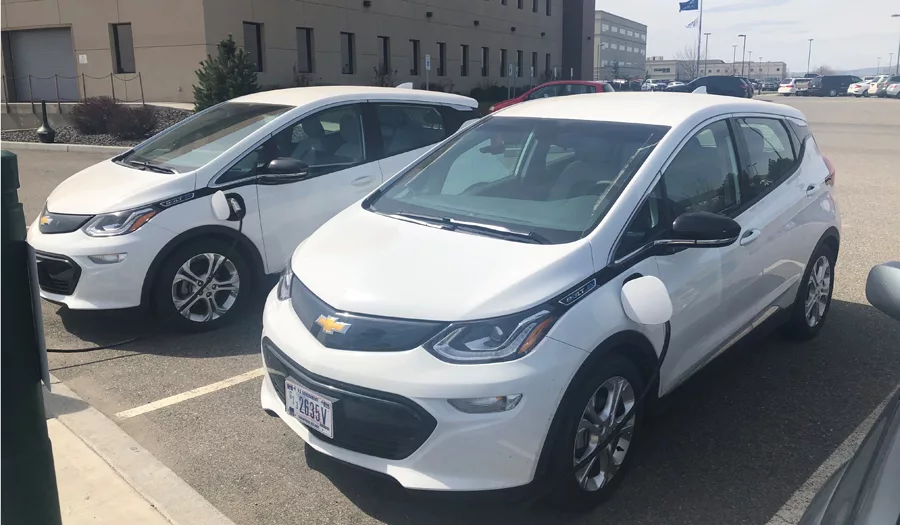
Home » Mission Support Alliance boosts its alternative fuel vehicle fleet
Mission Support Alliance boosts its alternative fuel vehicle fleet

April 15, 2019
By Kevin Anthony
The message is simple. Clean, you might say.
While cleaning up one of the biggest environmental messes in
the United States, it’s best to leave as small a footprint as possible.
It’s an attitude that Mission Support Alliance stresses in its role as a key contractor at the Hanford nuclear reservation. And a big reason why the company has been increasing its fleet of alternative fuel vehicles, or AFVs, for more than a decade.
“You can’t clean up 1940s waste and at the same time
contribute to another environmental issue,” said Dave Baie, MSA’s director of
fleet services.
“It doesn’t take a lot of forethought to know the right way
to do it,” he added.
Mission Support Alliance’s role at the Hanford site is
taking care of the infrastructure: security, utilities, fire protection and the
like. It also maintains the 365 miles of paved roads on the 580-square-mile
reservation, as well as a fleet of 1,800 vehicles.
MSA’s job is making sure it’s as easy as possible for
everyone else to do their job. It has some 2,000 employees on site, nearly a
quarter of the about 9,000 workers involved in the Hanford cleanup.
MSA has been evolving its fleet of cars and trucks to run on
alternative fuels since 2004. Back then, Baie said, it was less about the
environment and more about security.
“Initially when it started years ago, it was to reduce the
need of foreign fuel,” said Baie, a self-described “gear head” who has worked for
MSA at Hanford for 25 years.
The push for energy independence and security morphed into
support of an industry built around an emerging technology.
MSA has 63 hybrid vehicles and three electric, but most of
its nearly 1,000 AFVs are E-85, which means they run on fuel that is up to 85
percent ethanol.
About 20 million vehicles in the U.S. use E-85, also known
as FlexFuel. The primary component in ethanol is corn, and about 40 percent of
the corn grown in the U.S. goes toward biofuel.
Along the way, the reasons of security and industry became
more about the environment and the company’s carbon footprint.
Baie didn’t want to go too deep down the global warming
rabbit hole, but “if some of what the studies say is true, we want to minimize
our impact as much as possible.”
MSA’s fleet doesn’t include heavy trucks, which run on
traditional diesel. Mostly they are pickups, vans and small SUVs. But it does
include half-ton and one-ton four-door trucks hauling crews to off-road sites.
Once MSA decided to add AFVs to its fleet, it didn’t take
long to jump in with both feet. Within a year, half of the new vehicles it
added each year ran on alternative fuels. In fiscal year 2018, AFVs accounted
for two-thirds of the 230 added vehicles.
AFVs now make up 56 percent of the fleet.
“Our goal is to continue to get AFVs that fit with our
mission need,” Baie said, “and let the (AFV) numbers fall where they may.”
Along with the three electric cars, MSA has two charging
stations in place and two more waiting to be installed as more electric cars
are added.
Baie said he doesn’t expect electric vehicles to make up a
significant portion of the fleet until battery technology improves. MSA’s
electric cars are two Chevy Bolts and a Nissan Leaf — not exactly something you
want to take off-road — and electric trucks don’t yet meet the company’s needs.
But, Baie added, a big breakthrough will happen sooner or
later.
“That’s where I think we’ll be going someday,” he said.
There is an added financial cost of using AFVs. E-85 fuel costs
about 10 percent more than standard gas, and fuel efficiency is 15 percent to
20 percent less than traditional gas engines.
The miles per gallon is not much of a concern at Hanford,
Baie said, because most of the driving is short trips or off-road, hardly
optimal miles per gallon to begin with. So, the drop off usually amounts to a
mile or two per gallon.
“The biggest thing it means to the general public is (less)
greenhouse gas production,” Baie said, adding, “We know we’re doing the right
thing.”
Local News Auto & RV Industry Environment
KEYWORDS april 2019





